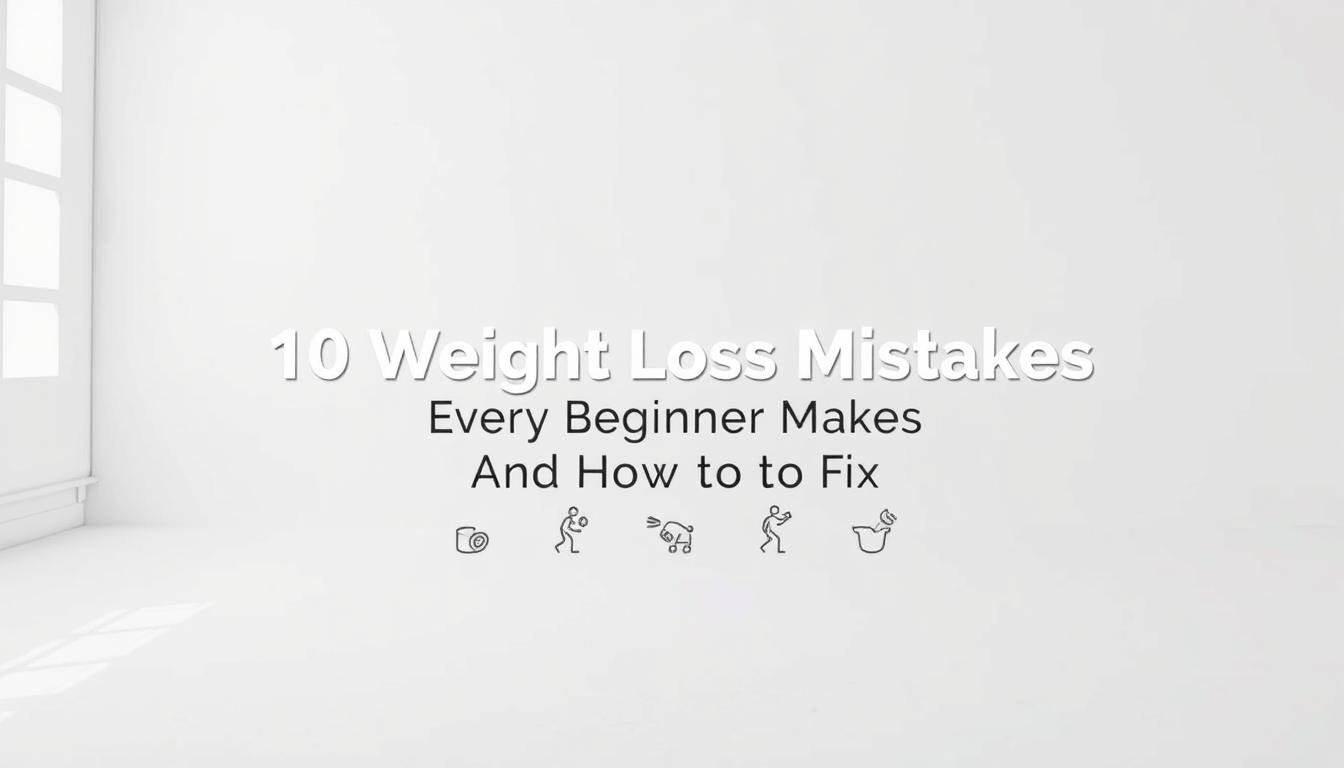10 Weight Loss Mistakes Every Beginner Makes
Starting a weight loss journey is like opening a new chapter. You plan meals, exercise, and track your steps. But sometimes, the scale doesn’t move, and you lose motivation. It’s common.
Many of us make the same mistakes without realizing it. This guide aims to help you spot these errors early. So, you can turn frustration into progress.
Weight loss mistakes often start with good intentions. Cutting carbs too much, doing too much cardio, or skipping meals might seem like quick fixes. But they can lead to setbacks.
The truth is, lasting success isn’t about being perfect. It’s about learning from mistakes. This article will cover the 10 most common errors beginners make. We’ll explain why they happen and how to fix them. By the end, you’ll know how to avoid common pitfalls and stay on track.
Key Takeaways
- 10 weight loss mistakes trap many beginners, but they’re fixable.
- Most mistakes stem from unrealistic expectations or lack of knowledge.
- Learning to avoid these errors builds confidence and momentum.
- Weight loss mistakes to avoid include poor planning and unhealthy habits.
- Small adjustments create lasting change, not temporary fixes.
Why Most Weight Loss Journeys Fail Before They Begin
Weight loss setbacks often start long before the first diet or workout. Hidden weight loss failure factors like poor planning or mindset traps can derail progress before it begins. Let’s uncover the real reasons many struggle and how to shift course early.
The Psychology Behind Failed Weight Loss Attempts
Studies show that negative self-talk and fear of failure create a mental block. Many begin with “all or nothing” thinking: “If I slip up once, I’ve failed entirely.” This mindset fuels discouragement. Weight loss setbacks become excuses to quit instead of lessons to learn from.
“Success isn’t about avoiding mistakes, but learning to bounce back.” — Behavioral psychologist Dr. Elena Martinez
What Successful Weight Loss Really Looks Like
- Slow, steady progress over 1-2 pounds weekly
- Flexibility with occasional treats
- Focus on habits, not quick fixes
Winners track non-scale victories: better energy, stronger muscles, or improved sleep—not just the scale.
Setting Yourself Up for Sustainable Success
Start with micro-goals: 15-minute walks daily or swapping one sugary drink per week. Build accountability by sharing goals with a friend or using apps like MyFitnessPal. Celebrate small wins to rewire your mindset toward progress, not perfection.
Unrealistic Expectations: The Dream vs. Reality

Many beginners make common weight loss errors by expecting quick results. Social media and ads show fast changes, leading to weight loss pitfalls. But, losing weight safely is about 1–2 pounds a week, with some ups and downs.
| Myth | Reality |
|---|---|
| “I’ll lose 20 pounds in a month!” | Healthy loss is 1–2 lbs/week |
| Weight loss is a straight line | Plateaus and fluctuations are normal |
“Expecting perfection sets you up to feel like a failure. Progress, not perfection, builds success.” — Dr. Emily Carter, Nutrition Specialist
Set goals based on your age, starting weight, and how active you are. Focus on non-scale wins like more energy or strength. Celebrate small victories to stay motivated.
Be patient and let science guide you, not social media. This approach will help you stay on track.
Crash Dieting: The Fastest Way to Regain Weight
Crash diets promise quick fixes, but they’re among the worst weight loss blunders to avoid. They cut calories too much, making your body fight back. This turns short-term weight loss into a long-term struggle.
Why Extreme Calorie Restriction Backfires
Your body reacts by increasing hunger hormones like ghrelin. Your metabolism slows down to save energy. This makes losing weight unreliable.
A study in Obesity Reviews found 80% of dieters regain weight within a year. Your brain sees drastic calorie cuts as famine, not dieting.
“The body adapts to survive—not to lose weight quickly.”
Metabolic Adaptation: Myths and Realities
- Metabolic “damage” is a myth—your body adapts, not breaks.
- Gradual cuts (500–750 calories below maintenance) maintain muscle and energy.
- Skipping meals slows your metabolism more than moderate deficits.
Building a Sustainable Caloric Deficit
Follow these steps to lose weight without crashing:
- Calculate your maintenance calories using online calculators like the Mifflin-St Jeor equation.
- Create a deficit of 250–500 calories daily through diet and exercise.
- Reassess every 4 weeks to adjust as your body adapts.
Patience beats punishment. Sustainable change wins the long game—avoiding the weight loss blunders to avoid means focusing on habits, not just numbers.
Overlooking Protein Intake in Your Diet

Many people overlook the importance of protein in their diet. It’s not just for bodybuilders. Protein helps control hunger and boosts metabolism. Let’s explore how to avoid this mistake and make meals work for you.
How Protein Supports Weight Loss
- Satiety Power: Protein keeps you full longer, reducing mindless snacking.
- Metabolism Boost: Digesting protein burns more calories than carbs or fats.
- Muscle Protection: It stops muscle loss during calorie cuts, keeping your metabolism strong.
Optimal Protein Sources for Any Diet
Eat smart, not restrictive:
- Omnivores: Grilled chicken, Greek yogurt, eggs, and wild-caught salmon.
- Vegetarians: Tofu, Greek yogurt, lentils, and quinoa.
- Vegans: Tempeh, chickpeas, edamame, and plant-based protein powders like Garden of Life or Vega.
Easy Ways to Boost Daily Protein
Small swaps make a big difference:
- Add a scoop of protein powder to smoothies or oatmeal.
- Snack on hard-boiled eggs or roasted chickpeas.
- Swap pasta for zucchini noodles topped with turkey meatballs.
Making protein a priority is simple. Small changes can make a big impact. This way, you avoid common weight loss missteps and keep your diet on track.
The Cardio-Only Approach to Exercise
Cardio helps burn calories and improves heart health. But, relying only on it is a weight loss pitfall many beginners face. Doing too much treadmill running or cycling without strength training can cause plateaus and muscle loss.
Here’s why this is a common weight loss error: muscles burn more calories than fat when you’re not moving. Skipping strength workouts means missing out on building lean tissue. This tissue is key to boosting your metabolism. Over time, your body gets used to cardio, needing longer sessions to burn the same calories. This makes progress harder.
- Cardio-only routines often increase hunger hormones, leading to overeating.
- They can create “skinny fat” body types with low muscle mass.
- Resistance training preserves metabolism and shapes a stronger physique.
Start by adding two strength sessions a week. Focus on big moves like squats, push-ups, and rows. Gradually increase weights or reps to grow muscles. This “progressive overload” principle helps you keep getting better. Pair this with cardio for a balanced plan that avoids the weight loss pitfalls of relying on one method alone.
10 Weight Loss Mistakes That Sabotage Your Progress

Successful weight loss means avoiding common mistakes. These weight loss mistakes to avoid often come from bad habits or mindset issues. Spotting these weight loss failure factors early helps you make changes before it’s too late.
Physical Mistakes vs. Mental Barriers
Physical errors include skipping protein, eating too many “healthy” snacks, or focusing only on cardio. Mental barriers like thinking everything must be perfect or using food for comfort are just as harmful. Both can stop your progress if you ignore them.
- Skipping protein-rich meals
- Overreliance on cardio
- Ignoring sleep patterns
- Labeling foods as “good” or “bad”
- Skipping hydration
Signs You’re Making These Mistakes Without Realizing
Watch for these red flags:
- Frequent mood swings tied to eating habits
- Unplanned weekend binges
- Using exercise as punishment
- Ignoring hunger/fullness cues
- Comparing progress to others
Deal with these signs early to turn setbacks into chances for growth. Being aware of yourself is essential for lasting change.
Neglecting Sleep and Stress Management
Sleep and stress management are key to losing weight. Not focusing on them can lead to weight loss setbacks. This is due to hormonal imbalances and poor choices. Let’s see how making these areas a priority can help you succeed.
The Cortisol-Weight Gain Connection
Stress makes your body release cortisol, a hormone that increases hunger and fat storage. It also makes you crave unhealthy foods. This is a big weight loss blunder to avoid. Chronic stress can slow down your metabolism and lead to more eating.
Practical Sleep Hygiene for Weight Loss
- Aim for 7-9 hours of sleep each night. Less than 7 hours can slow down your metabolism by up to 2%.
- Keep a regular bedtime and wake-up time, even on weekends.
- Make your bedroom dark and cool to help you sleep better.
Good sleep helps lower hunger hormones and increase fullness hormones. This reduces the chance of eating too much.
Stress-Reduction Techniques That Support Your Goals
Mindfulness, like 10-minute meditation, can lower cortisol by 14%, a 2023 Johns Hopkins study found. Try these methods:
- Time-blocking: Set aside 30 minutes each day for relaxing activities like reading or walking.
- Boundary-setting: Turn off devices an hour before bed to sleep better.
- Deep breathing exercises: Do 5-10 minutes of deep breathing to instantly reduce stress.
These steps are as important as diet and exercise. Small changes in sleep and stress habits can lead to lasting results.
The Hidden Calories in “Healthy” Foods
Weight loss missteps often hide in plain sight. Foods labeled “natural” or “low-fat” can be bad for you. They might have added sugars, fats, or be too big. Even small snacks can stop you from reaching your goals.
- Granola: It’s full of sugar and oil. Just 1/4 cup can have over 200 calories.
- Smoothie Bowls: Add-ins like honey, coconut flakes, or full-fat yogurt add a lot of calories.
- Salad Dressings: Many store-bought ones have more sugar than a candy bar.
- “Sugar-Free” Snacks: Artificial sweeteners don’t make crackers or protein bars calorie-free.
Getting the portion right is key. A handful of almonds (160 calories) can quickly turn into more. Olive oil on salads can add 100+ calories before you even eat the veggies.
“Eating healthy doesn’t mean eating endlessly healthy.”
Check nutrition labels for serving sizes and ingredients. Make your own dressings instead of buying them. Choose fresh fruit over pre-made acai bowls. Being mindful of portions makes “healthy” foods your friends, not enemies.
Not Tracking Progress Accurately
Tracking your progress is vital to avoid common 10 weight loss mistakes. Many overlook non-scale wins or focus too much on the scale. This can make it hard to see real progress and adjust your plans.
Beyond the Scale: Better Metrics for Success
Don’t just rely on the scale. Instead, track these:
- Weekly measurements: waist, hips, and thighs show changes the scale might hide.
- Progress photos: capture posture and muscle tone shifts.
- Workout benchmarks: track reps, endurance, or speed improvements.
- Energy levels: note daily stamina or mood shifts.
- Sleep quality: log hours and restfulness for holistic insights.
Tools and Apps That Make Tracking Simple
Here are some tools to help:
- MyFitnessPal: logs meals and activity in one place.
- Fitbit or Apple Watch: track steps, heart rate, and sleep patterns.
- Progress Journal: a physical notebook or digital app to jot down weekly reflections.
Creating a Progress Journal That Motivates
Write weekly entries about:
– Small wins like “I fit into old jeans” or “ran 10 minutes without stopping.”
– Adjustments made and lessons learned. Celebrate consistency over perfection. This turns setbacks into learning tools, not reasons to quit.
The All-or-Nothing Mindset Trap
Weight loss setbacks often come from seeing progress in black and white. Thinking you must follow a diet perfectly or else is a big weight loss failure factor. This mindset makes small mistakes seem like reasons to quit, leading to frustration.
How Perfectionism Leads to Abandonment
Perfectionism sees missed meals or treats as complete failures. Studies show this mindset raises stress hormones like cortisol. This slows down your metabolism and makes weight loss setbacks worse. Instead, see a slip as a chance to learn.
Building Resilience After Diet “Failures”
- Practice self-compassion: Treat yourself as kindly as a friend would.
- Identify triggers: Track when and why slips happen to address root causes.
- Restart immediately: Get back on track the next meal or workout without guilt.
The 80/20 Approach to Sustainable Weight Loss
“Consistency, not perfection, drives long-term success.” – Academy of Nutrition and Dietetics
Try to make healthy choices 80% of the time. This lets you be flexible without losing progress. For instance, eat whole foods most days but enjoy treats sometimes. Research shows this balance reduces burnout and helps stick to goals.
Going Solo: Why Support Systems Matter
Many people make a big mistake by trying to lose weight alone. Studies show that those with support are twice as likely to succeed. Why? Having someone to connect with keeps you motivated and on track—something many overlook.
“Alone we can do so little; together we can do so much.” — Helen Keller
- Join online groups like Noom or MyFitnessPal communities for daily check-ins.
- Pair with a friend for workouts or meal prep sessions.
- Consult registered dietitians or certified coaches for personalized plans.
Support doesn’t have to be expensive. Local libraries offer free wellness workshops, and apps like Fitbod are affordable. Feeling scared to ask for help? Remember, it’s a sign of strength, not weakness.
When you face challenges, a support system can offer new ideas and understanding. They help you see habits you might miss, turning obstacles into chances to learn. Don’t make the weight loss mistakes to avoid by going it alone. Your future self will be grateful.
Conclusion: Turning Weight Loss Mistakes Into Stepping Stones for Success
Knowing the 10 weight loss mistakes is your first step to lasting change. Many common mistakes, like crash diets or ignoring protein, can mislead beginners. Understanding these errors helps you approach your goals with clarity.
Weight loss isn’t about avoiding all slip-ups but learning from them. Tracking progress, prioritizing sleep, and building support systems turn setbacks into stepping stones. Small adjustments, like adding protein-rich snacks or short workouts, create habits that stick.
Focus on progress, not perfection. The 10 weight loss mistakes highlighted here show that success comes from consistent effort, not flawless execution. Start with one or two changes, like using a fitness app to log meals or joining a walking group. Each adjustment brings you closer to your goals.
Remember the 80/20 approach: 80% of your focus on healthy habits, leaving 20% room for flexibility. This mindset reduces pressure and keeps you moving forward, even after missteps. Celebrate small wins and adjust as needed—adaptability is key to long-term success.
Take the knowledge from this guide and start applying it today. Every mistake identified here is a roadmap to improvement. With patience and self-compassion, you can transform awareness of common weight loss blunders into actionable steps. Your journey matters, and every effort counts—begin with what’s manageable, and watch progress grow over time.
FAQ
What are the 10 weight loss mistakes beginners often make?
How do I know if I’m making weight loss blunders?
Why do weight loss attempts often fail?
What role does protein intake play in weight loss?
Can focusing only on cardio lead to weight loss setbacks?
How can I track my weight loss progress effectively?
What are the effects of poor sleep and stress on weight loss?
How can I avoid hidden calories in “healthy” foods?
What is the 80/20 approach to eating?
Should I seek support for my weight loss journey?
editor's pick
latest video
news via inbox
Nulla turp dis cursus. Integer liberos euismod pretium faucibua




